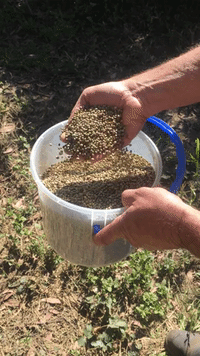Source: abc.net.au

Eighty years after hemp cultivation was banned in Australia, the industry is enjoying a second coming.
Sir Joseph Banks sent hemp seeds on the First Fleet so the fledgling colony could establish a crop to help make rope and sails.
However, drug concerns led to cultivation being banned in 1937.
In the background of a ban on human consumption in Australia, which has just been overturned, the industry has been slowly rebuilding for export for the past 20 years.
Hunter Valley-based farmer Bob Doyle, the head of the Australian Industrial Hemp Alliance, said Australian growers have been exporting hemp seeds as a food product for several years, even under the domestic human consumption ban.
Newcastle organic shop owner Phil Maher agrees that the seeds are very popular.
"We get inquiries about hemp seeds every day, but we can't talk about their fantastic benefits. So we point people to other avenues to get the appropriate information," he said.
In Australia, they can only be sold as a component of skincare products.
But high in protein and omega 3, they are tipped to become the next superfood on local supermarket shelves.
"They are really, really versatile, so they don't need any preparation," Mr Maher said.
The industry is now predicted to double in size over the next 12 months after clearing the major legislative hurdle.
"At the moment most of that grain will end up being imported," Mr Doyle said.
"Australia is actually not ready to grow enough of its own."
The industry has struggled to expand as farmers battled restrictive legislation.
"To date it's been the government and it's been from police. They've been the ones holding up food approval," Mr Doyle said.
He said the problem is that the low-THC industrial plant looks the same as the plant used as an illicit drug.
Now that Federal Government approval is through it is hoped that NSW state legislation will be finalised by the end of the year.
As a fibre product, the outside of the stalk, known as the bast, is exported to be made into rope and other textiles.
The inside pith is being processed domestically as a building product, to be used in walls.
"This is a great opportunity for the farmers in New South Wales, we know this industry is worth about $150 million in the United States and our farmers can get a piece of that now right here," said NSW Primary Industries Minister Niall Blair.
Medicinal industry still on the outer
Mr Doyle said that as Australia is already very good at growing grain crops it would be relatively easy to transition to the crop.
"From a fibre point of view, people compare it to growing cotton," he said.
"It's one plant with three very good uses — food, fibre and medicinal."
While the hemp industry is looking to expand for food and fibre, roadblocks remain in the medicinal sector.
The state's chief scientist, Mary O'Kane, recently said there are still legal hurdles around the local production of medicinal cannabis.
At the moment, terminally ill patients have to rely on imported products or the black market.
"New South Wales is leading the nation on medicinal cannabis trials," said Minister Niall Blair.



No comments:
Post a Comment